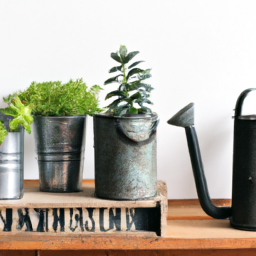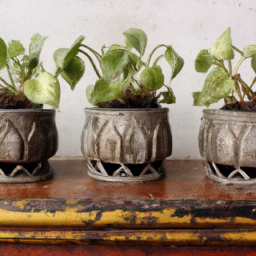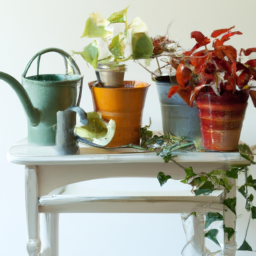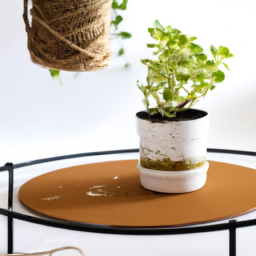
Hey there plant lovers! Are you tired of the same old boring planters? Looking to add a touch of personality and style to your indoor or outdoor space? Well, you’re in luck because today we’re diving into the world of unique planters. In this blog post, we’ll explore the art of turning vintage finds into stylish containers that are sure to make a statement. So, if you’re ready to get creative and add a touch of uniqueness to your plant collection, keep reading! Unique planters: turning vintage finds into stylish containers is about to become your new favorite hobby.
The Beauty of Repurposing: Transforming Vintage Items into Unique Planters
Have you ever stumbled upon a vintage item and wondered how you could give it a new lease on life? Well, look no further! In this guide, we will explore the art of repurposing vintage finds into stylish planters that will add a touch of uniqueness to your home or garden. Get ready to unleash your creativity and create stunning plant displays that are sure to impress!
Finding the Perfect Vintage Item
The first step in this exciting journey is finding the perfect vintage item to repurpose into a planter. Thrift stores, flea markets, and even your own attic can be treasure troves of unique finds waiting to be transformed. Keep an eye out for items such as old suitcases, wooden crates, tea tins, or even vintage kitchenware. The possibilities are endless, so let your imagination run wild!
When selecting your vintage item, consider its size, shape, and material. You want to choose something that will not only accommodate your plants but also complement their beauty. For example, a vintage teapot can make an adorable planter for small succulents, while an old wooden barrel can house larger plants like ferns or palm trees.
Once you’ve found your vintage gem, it’s time to prepare it for its new life as a planter. Clean it thoroughly, removing any dirt, rust, or debris. If needed, sand down rough edges or apply a fresh coat of paint to enhance its appearance. Remember, the goal is to transform your vintage find into a stylish container that will showcase your plants in the best possible way.
Choosing the Right Plants
Now that you have your vintage item ready, it’s time to select the perfect plants to bring it to life. Consider the size, lighting requirements, and overall aesthetic of your vintage planter. Are you looking to create a vibrant flower display or a lush green oasis? The choice is yours!
If you’re opting for flowers, choose varieties that will thrive in the conditions your planter can provide. For instance, if your vintage item has limited drainage, opt for plants that can tolerate moist soil, such as impatiens or begonias. If your planter is exposed to direct sunlight, look for sun-loving plants like petunias or marigolds.
If you prefer a green oasis, consider plants with different heights, textures, and shades of green. Mix trailing plants like pothos or ivy with upright plants like snake plants or peace lilies. This combination will create a visually appealing arrangement that adds depth and interest to your vintage planter.
Remember to also consider the size of your vintage item when selecting plants. Ensure that they have enough space to grow and thrive without overcrowding each other. You want your planter to be a harmonious blend of vintage charm and natural beauty.
Planting and Maintenance
With your vintage item cleaned and your plants chosen, it’s time to bring them together and create a masterpiece. Start by adding a layer of small rocks or pebbles at the bottom of your planter to aid in drainage. This will prevent water from pooling and potentially damaging the roots of your plants.
Next, fill your planter with a high-quality potting mix, leaving enough space for your plants to settle comfortably. Gently remove your plants from their nursery pots, loosen their roots, and place them in the planter. Arrange them in a way that creates a visually pleasing composition, considering their growth habits and colors.
Once your plants are in place, gently pat down the soil around them, ensuring they are secure and stable. Water your planter thoroughly, allowing the water to drain out from the bottom. Be mindful not to overwater, as this can lead to root rot. Regularly check the moisture level of the soil and water accordingly.
As your plants grow, provide them with the necessary care, including regular watering, fertilizing, and pruning. Keep an eye out for any signs of pests or diseases, and take appropriate measures to protect your plants. With proper care, your vintage planter will continue to flourish and bring joy for years to come.
Repurposing vintage finds into unique planters is not only a creative endeavor but also a sustainable way to breathe new life into forgotten treasures. Follow these steps, let your imagination guide you, and watch as your vintage planters become the focal point of your home or garden. Happy planting!

Creative Ideas for Vintage Planters: Adding Style and Charm to Your Garden
Gardening is not just about growing plants; it’s also about creating a beautiful and inviting space. One way to add style and charm to your garden is by using unique planters. Vintage finds can be transformed into stylish containers that not only serve as functional planters but also become eye-catching focal points in your outdoor space. In this guide, we will explore creative ideas for turning vintage finds into unique planters.
Finding the Perfect Vintage Planter
The first step in creating unique planters is finding the perfect vintage item to repurpose. Keep an eye out for old containers, such as buckets, barrels, crates, or even discarded furniture pieces like chairs or dressers. Thrift stores, flea markets, and online marketplaces can be great sources for finding these hidden gems.
When choosing a vintage planter, consider its size, shape, and material. A larger planter can accommodate a variety of plants, while a smaller one may be suitable for succulents or herbs. The shape of the planter should complement the plants you intend to grow, and the material should be durable enough to withstand outdoor conditions.
Once you’ve found the perfect vintage item, it’s time to get creative and turn it into a stylish planter.
Prepping and Repurposing
Before repurposing your vintage find, it’s important to clean and prepare it properly. Remove any dirt, rust, or old paint using a wire brush or sandpaper. If the item has any holes or cracks, consider patching them up to ensure proper drainage.
Once your vintage item is clean and prepped, it’s time to transform it into a planter. Depending on the item, you may need to make some modifications. For example, if you’re using an old dresser, remove the drawers and shelves to create individual planting spaces. If you’re repurposing a barrel, consider adding drainage holes at the bottom.
Consider adding a fresh coat of paint or stain to your vintage planter to enhance its visual appeal. Choose colors that complement your garden’s overall aesthetic or go for a bold, contrasting look to make a statement. Don’t be afraid to get creative and experiment with different painting techniques, such as distressing or stenciling, to add a unique touch.
Planting and Styling
Now that your vintage planter is ready, it’s time to choose the perfect plants and style them in an appealing way. Consider the size and depth of your planter when selecting plants. Tall plants like bamboo or ornamental grasses can add height and drama, while trailing plants like ivy or petunias can cascade beautifully over the edges.
Grouping plants with different textures, colors, and heights can create a visually interesting arrangement. Mix flowers, herbs, and foliage plants to add variety and depth to your planter. Don’t forget to consider the lighting and watering needs of the plants you choose and place them accordingly.
To add an extra touch of charm, consider incorporating decorative elements such as fairy lights, vintage signs, or small garden ornaments. These accessories can enhance the overall aesthetic of your vintage planter and make it truly unique.
Remember to regularly maintain your vintage planter by watering, fertilizing, and pruning as needed. Keep an eye out for any signs of pests or diseases and take appropriate action to ensure the health of your plants.
In conclusion, turning vintage finds into stylish planters is a creative and rewarding way to add style and charm to your garden. By finding the perfect vintage item, prepping and repurposing it, and carefully selecting and styling plants, you can create unique planters that become beautiful focal points in your outdoor space. So, start exploring thrift stores and flea markets, unleash your creativity, and transform your garden with these creative ideas for vintage planters!

Tips for Choosing and Preparing Vintage Containers for Planting: Creating a Unique Garden Display
Introduction
Welcome to the world of unique planters, where vintage finds are transformed into stylish containers for your beloved plants. If you’re looking to add a touch of personality and charm to your garden, repurposing vintage items as planters is a fantastic way to achieve just that. In this guide, we’ll walk you through the process of choosing and preparing vintage containers for planting, helping you create a truly unique garden display that will be the envy of all your neighbors.
1. Finding the Perfect Vintage Container
The first step in creating your unique garden display is finding the perfect vintage container to repurpose as a planter. Here are some tips to help you in your search:
Consider the Size: Vintage containers come in all shapes and sizes, so think about the space you have available and the type of plants you want to grow. Larger containers can accommodate a variety of plants, while smaller ones are ideal for succulents or herbs.
Look for Interesting Shapes and Designs: Vintage containers often have unique shapes and intricate designs that can add visual interest to your garden. Keep an eye out for containers with interesting textures, patterns, or decorative elements.
Check for Drainage Holes: Good drainage is crucial for the health of your plants, so make sure the vintage container you choose has drainage holes or can be easily drilled to create them.
2. Cleaning and Preparing the Vintage Container
Once you’ve found the perfect vintage container, it’s time to clean and prepare it for planting. Follow these steps to ensure your container is ready to house your plants:
Remove Any Dirt or Debris: Start by removing any dirt, dust, or debris from the container. Use a soft brush or cloth to gently scrub away any stubborn dirt or stains.
Sanitize the Container: To prevent the transfer of any pests or diseases to your plants, sanitize the vintage container. Mix a solution of one part bleach to nine parts water and use a sponge or cloth to wipe down the entire container, both inside and out.
Drill Drainage Holes (if necessary): If your vintage container doesn’t have drainage holes, you’ll need to drill them yourself. Use a drill with a bit appropriate for the material of the container (e.g., ceramic, metal, wood) and carefully create several small holes in the bottom.
3. Adding a Protective Layer and Soil
Now that your vintage container is clean and prepared, it’s time to add a protective layer and soil to create a suitable environment for your plants:
Add a Protective Layer: To prevent soil from escaping through the drainage holes, place a layer of small rocks or broken pottery pieces at the bottom of the container. This will promote proper drainage while keeping the soil in place.
Choose the Right Soil: Different plants have different soil requirements, so choose a potting mix that is suitable for the types of plants you’ll be growing. Fill the container with enough soil to accommodate the roots of your plants, leaving some space at the top for watering.
Consider Adding Fertilizer: If you want to give your plants an extra boost, consider mixing a slow-release fertilizer into the soil before planting. This will provide essential nutrients to your plants over time.
Conclusion
By following these tips for choosing and preparing vintage containers for planting, you’ll be well on your way to creating a unique garden display that showcases your creativity and love for plants. Remember to have fun with the process and let your imagination guide you as you repurpose vintage finds into stylish planters. Happy gardening!
Crisp Recap
If you’re looking to add a touch of charm and personality to your indoor or outdoor space, why not consider using unique planters made from vintage finds? Not only are they a sustainable option, but they also bring a sense of history and character to your plants. In this blog post, we’ll explore how you can turn those old, forgotten objects into stylish containers for your beloved greenery.
One of the best things about using vintage finds as planters is the endless possibilities they offer. From old teapots and tin cans to vintage suitcases and wooden crates, there’s no shortage of unique items that can be repurposed. The key is to look for objects that are sturdy, have drainage holes or can be easily modified, and are large enough to accommodate the root system of your plants. Once you’ve found your perfect vintage piece, all that’s left to do is give it a good clean, add some potting soil, and plant your favorite greens. Whether you choose to display them indoors or create a charming outdoor garden, these repurposed planters are sure to be conversation starters and a delightful addition to your space.
Let me leave you with some FAQs:
Q1: Where can I find unique vintage planters?
A1: You can find unique vintage planters in various places. Thrift stores, flea markets, and antique shops are great places to start your search. Online marketplaces like Etsy and eBay also offer a wide selection of vintage planters. Additionally, you can try attending local garage sales or estate sales, as they often have hidden gems waiting to be discovered.
Q2: What types of vintage items can be turned into planters?
A2: The possibilities are endless when it comes to turning vintage items into planters. Old teapots, tin cans, wooden crates, vintage suitcases, and even old boots can be transformed into unique and stylish planters. Get creative and think outside the box – you’ll be amazed at the charming and unexpected results!
Q3: How do I prepare a vintage item to be used as a planter?
A3: Preparing a vintage item to be used as a planter is relatively simple. First, ensure that the item is clean and free from any dirt or debris. If necessary, give it a gentle wash or wipe down. Next, depending on the material, you may want to apply a waterproof sealant or line the interior with plastic to protect it from moisture. Finally, make sure to create drainage holes at the bottom of the planter to prevent waterlogging and promote healthy plant growth.
Q4: What types of plants work well in vintage planters?
A4: Vintage planters can accommodate a wide range of plants, depending on their size and shape. For smaller vintage planters, succulents, cacti, and small herbs make excellent choices. Larger planters can accommodate a variety of indoor plants like pothos, spider plants, or even flowering plants like orchids or peace lilies. Consider the lighting conditions and the specific needs of the plants you choose to ensure their success in the vintage planter.
Q5: How can I incorporate vintage planters into my home decor?
A5: Vintage planters can add a touch of charm and personality to your home decor. You can place them on windowsills, shelves, or side tables to create eye-catching displays. Grouping multiple vintage planters together can create a visually appealing focal point in any room. Additionally, you can mix and match vintage planters with modern ones to create a unique and eclectic look. Don’t be afraid to experiment and let your personal style shine through!

Lisa Chen is a seasoned indoor gardening expert and the author of several bestselling books on the topic. With a background in horticulture and urban farming, Lisa is dedicated to helping urban dwellers embrace the joys of cultivating green spaces indoors. Her detailed guides and hands-on tips empower readers to transform their living spaces into thriving plant sanctuaries.


